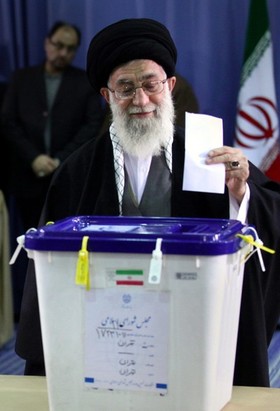UPDATES
Iran election 2012: Khamenei vs Ahmadinejad
March 7, 2012 | Sharyn Mittelman

Amid Iran’s nuclear standoff and reports of its human rights abuses, the Iranian Parliamentary elections on March 2 garnered suprisingly little outside interest.
This was because the whole event was simply a contest amongst various strains of extremists – with reformists largely excluded from taking part, or boycotting. It was essentially a battle between supporters of Iran’s Supreme leader Ayatollah Ali Khamenei and President Mahmoud Ahmadinejad. The election results are in and it seems Ahmadinejad lost the battle and now may be reduced to being a ‘lame duck’ President.
The showdown follows two years of a public rift between the leaders. Khamenei believes that Ahmadinejad challenged his authority on government affairs including foreign policy and intelligence. The rift became apparent in April when Ahmadinejad publicly opposed Khamenei’s order to reinstate the intelligence minister, who had been dismissed by Ahmadinejad. The President then boycotted government meetings for more than a week in protest. In response Khamenei threatened to get rid of the position of President and replace it with ‘Prime Minister’ so that the Supreme Leader can retain his control over all Iranian affairs. He also had Ahmadinejad allies arrested and purged.
The election results will now further cement Khamenei’s power, as his supporters won over 75% of seats in the election. The United Principlist Front, a coalition of Khamenei supporters, took some 88 seats in the 290-seat parliament. The Front for the Stability of the Islamic Revolution, a parliamentary group led by hard-line cleric Mohammad Taqi Mesbah Yazdi, considered to be Ahmadinejad’s spiritual adviser, took approximately 44 seats.
The President may spend the rest of his term merely trying to survive it. Ahmadinejad is likely to be summoned to an unprecedented hearing in the parliament to answer questions regarding his handling of the economy. Critics argue that Ahmadinejad inflicted higher inflation on Iranians by cutting food and fuel subsidies, and replacing them with cash handouts of around US$38 a month per person. Depending on his answers, the parliament could even seek impeachment.
In addition, on March 4, Iran’s Prosecutor General Gholam Hossein Mohseni-Ejehi announced that the second round of the trial for a $2.6 billion embezzlement scandal will take place next week. Among those linked to the scandal and may be facing charges are senior Ahmadinejad allies including his Chief of Staff, Esfandiar Rahim Mashaie.
According to the Iranian Interior Ministry the election turnout was 64 percent, which pleased the government. However, given that the previous parliamentary election turnout was just above 50 percent, Opposition figures have questioned the figure especially given that many reformists boycotted the election.
Implications of the election?
The outcome of the election is unlikely to impact Iran’s foreign policy given that Khamenei and Ahmadinejad both adopted a confrontational stance towards the West, and promoted Iran’s nuclear program. However, it has strengthened Khamenei’s grip on power.
Karim Sadjadpour, an Iran analyst at the Carnegie Endowment for International Peace said:
“Khamenei has effectively rendered what was already a rubber stamp parliament into an iron stamp parliament.”
Babak Dehghanpisheh writes in Time:
“The victory in the parliamentary vote that weakens Ahmadinejad, combined with the repression that has sidelined the opposition Green Movement, allows Khamenei to dismiss any talk of internal political strife and claim that Iran is united in the face of Western sanctions and Israeli military threats.”
The Associated Press reported:
“The results also greatly reduce Ahmadinejad’s leverage to have a protege clear the ruling clerics’ election vetting process and become a candidate to succeed him in mid-2013. It now seems likely that only staunch Khamenei loyalists could be in the running. ‘It appears that the era of `Ahmadinejadism’ in Iran’s political history is gradually coming to an end,’ said prominent Tehran-based political analyst Davoud Hermidas Bavand. What that means is a much bigger comfort zone for the ruling system in a volatile time.”
Where were the reformists?
The liberals and reformists that led the protests following the 2009 Presidential election were absent from the parliamentary ballots following relentless crackdowns and arrests. Few if any reformist candidates ran for parliament. Its leaders are now under house arrest or jailed and its access to media has been closed off.
Former Iranian President Mohammad Khatami considered by some to be the “spiritual leader of the reformist movement” demanded that political prisoners be freed and those under house arrest be released as a precondition for his movement’s participation. Since Khatami’s call was ignored, Ali Mohammad Gharibani, head of the Reformist Front Coordination Council, reportedly said:
“Despite efforts…to create an appropriate election climate, unfortunately more restrictions have been imposed. Therefore, the council has decided that it won’t issue any election list and won’t support anyone.”
However, Khatami who had urged Iranians not to vote, did end up voting on March 2.
Reformist candidates would also struggle to be selected in the elections because all candidates are vetted by the Guardian Council. Of those signed up to register more than 2,000 were rejected – including 33 sitting members of parliament.
The Iranian elections did highlight two key issues relevant to understanding the nuclear standoff – that the reformist movements in Iran are currently in abeyance and that the West lost a great opportunity in not supporting the protestors in 2009, and that as suspected, real power in Iran rests not with the President, but with the Supreme Leader and his Revolutionary Guard.
Sharyn Mittelman
Tags: Iran





